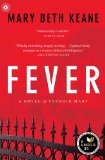Summary | Excerpt | Reading Guide | Reviews | Beyond the book | Read-Alikes | Genres & Themes | Author Bio

A bold, mesmerizing novel about the woman known as "Typhoid Mary," the first known healthy carrier of typhoid fever in the burgeoning metropolis of early twentieth century New York.
Mary Mallon was a courageous, headstrong Irish immigrant woman who bravely came to America alone, fought hard to climb up from the lowest rung of the domestic service ladder, and discovered in herself an uncanny, and coveted, talent for cooking. Working in the kitchens of the upper class, she left a trail of disease in her wake, until one enterprising and ruthless "medical engineer" proposed the inconceivable notion of the "asymptomatic carrier" - and from then on Mary Mallon was a hunted woman.
In order to keep New York's citizens safe from Mallon, the Department of Health sent her to North Brother Island where she was kept in isolation from 1907-1910. She was released under the condition that she never work as a cook again. Yet for Mary - spoiled by her status and income and genuinely passionate about cooking - most domestic and factory jobs were heinous. She defied the edict.
Bringing early twentieth-century New York alive - the neighborhoods, the bars, the park being carved out of upper Manhattan, the emerging skyscrapers, the boat traffic - Fever is as fiercely compelling as Typhoid Mary herself, an ambitious retelling of a forgotten life. In the hands of Mary Beth Keane, Mary Mallon becomes an extraordinarily dramatic, vexing, sympathetic, uncompromising, and unforgettable character.
Heart wrenching and dark but I was unable to put Fever down. Amidst the churning and changing of bustling New York City Mary is trying to find understanding and meaning and some element of peace in a world where she unwittingly has become an angel of death...continued
Full Review
 (894 words)
(894 words)
(Reviewed by First Impressions Reviewers).
Typhoid is a life-threatening illness caused by the bacteria Salmonella Typhi. Approximately 400 cases are found in the U.S. per year (mostly due to traveling) but it is prevalent in the developing world where a staggering 21.5 million people are infected per year, and 200,000 of those people die. Here is a short history of its origins, symptoms, and prevention.
History of Typhoid
 Between 430-424 BC an unidentified plague killed a full one third of the population of Athens. Among those who died was the the great general, orator and statesman, Pericles, the defacto leader of Athens. It was a major moment in time as it marked the end of the Golden Age of Pericles and shifted power in Greece from Athens to Sparta. Another famous Greek, ...
Between 430-424 BC an unidentified plague killed a full one third of the population of Athens. Among those who died was the the great general, orator and statesman, Pericles, the defacto leader of Athens. It was a major moment in time as it marked the end of the Golden Age of Pericles and shifted power in Greece from Athens to Sparta. Another famous Greek, ...

If you liked Fever, try these:

by Emma Donoghue
Published 2017
In Emma Donoghue's latest masterpiece, an English nurse brought to a small Irish village to observe what appears to be a miracle - a girl said to have survived without food for months - soon finds herself fighting to save the child's life.

by Melanie Crowder
Published 2016
The inspiring story of Clara Lemlich, whose fight for equal rights led to the largest strike by women in American history